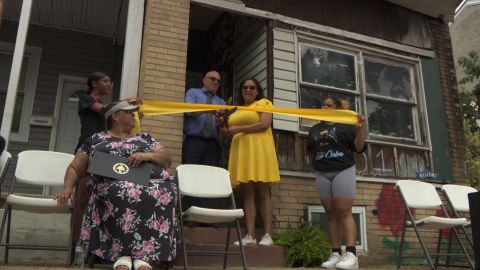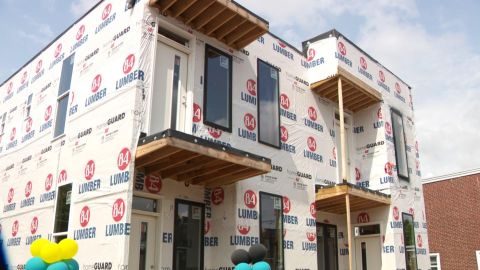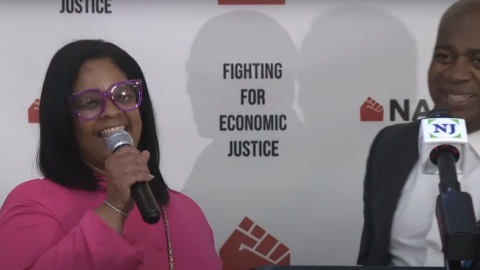How zoning can restrict, or even prevent, affordable housing
In this next installment of our series, “Roads to Recovery,” Christopher Booker reports on efforts to reform Connecticut’s land use laws, and the complicated mix of history, politics, and racial dynamics that impact who gets to live where. Advocates say restrictive land-use laws have led to inequality and a lack of affordable housing, while some local officials worry about losing a say over what can be built and where.
TRANSCRIPT:
Hari Sreenivasan:
In the first installment of our new series, “Roads to Recovery,” we reported on Connecticut’s efforts to provide an economic rescue for some of the state’s landlords and renters in Fairfield county.
While that support is in response to the continued economic fallout caused by the covid pandemic — the size and scale of the need points to a much larger, systemic challenge that runs throughout Connecticut: the lack of affordable housing.
In this next installment, Christopher Booker reports on efforts to reform Connecticut’s land-use laws, and the complicated mix of history, politics, and racial dynamics that impact who gets to live where. This segment is part of the initiative, Chasing the Dream: Poverty and Opportunity in America.
Richard Freedman:
The site is quite isolated.
Christopher Booker:
Yeah.
Real estate developer Richard Freedman has had plans for this nearly three-acre plot of land in Fairfield, Connecticut since 2014.
Richard Freedman:
So I buy this site and I’m thinking, you know, really?
Christopher Booker:
Yeah.
Richard Freedman:
Who could really care what goes up on this site?
Christopher Booker:
Tucked between Interstate-95, active train tracks, and a single house that sits at the far end of the property, the original plan was to build a four-story building with 95 rental apartments, 30 percent designated as affordable.
But after rejections from the town’s Planning and Zoning Commission and a half-decade of litigation, Freedman’s design on this plot of land is still just a plan.
Richard Freedman:
This is how towns fight affordable housing. If they can’t beat you in court, they know that if they deny you then if they can at least stall you and if they can drag it out long enough, sometimes they can kill it.
Christopher Booker:
And Fairfield is in desperate need of affordable housing. Only about 2.5 percent of the town’s more than 21,000 housing units are designated as affordable, fewer than any other city of its size in the state. To Freedman, Connecticut’s localized zoning rules coupled with an overwhelming preference for single-family homes on large lots is, in part, driving racial segregation.
Richard Freedman:
The fact that you cannot build multifamily housing. That prevents Black and Hispanic people from moving into your town. There’s just no two ways about it and the correlations are almost exact.
Christopher Booker:
In neighboring Bridgeport, the median household income is about $47,000, 80 percent of residents are minorities, and multifamily housing makes up more than 68 percent of the housing stock. In Fairfield, the median household income is nearly $139,000, 16 percent of residents are minorities, and multifamily housing makes up about 14 percent of the housing stock.
Richard Freedman:
Even 100 years ago, people generally didn’t use overtly racist or racial language when these zoning ordinances were put into place. But they have been devastatingly effective in maintaining a town like Fairfield, and many other towns in Connecticut, as almost entirely white.
Christopher Booker:
While inequality across Connecticut has been growing for decades, the events of 2020 – the COVID-19 pandemic and an increased awareness of racial inequality following last summer’s protests – has led to new momentum for reform to where and what kind of homes the state builds.
Sara Bronin:
I think that we have an unprecedented chance to change the way that we think about zoning’s impact on housing in Connecticut as a whole.
Christopher Booker:
Sara Bronin is the lead organizer and founder of Desegregate Connecticut, a coalition formed last summer to push for changes to the state’s land-use laws.
Sara Bronin:
Our zoning laws, like zoning laws all over the country, have become overly restrictive. Right now, zoning in Connecticut has largely locked in large lot, single-family, detached housing. And we know from demographic trends, even just looking at young people, they don’t necessarily want to live in that kind of housing.
Christopher Booker:
To quantify just how restrictive the state’s zoning is, this week, Desegregate Connecticut released a comprehensive zoning atlas of the state – to show exactly what can be built in each of Connecticut’s 169 towns, and under what rules.
In more than 90 percent of the state, a single-family home can be built without a public hearing under the existing zoning code. For a four-family home, that’s true in only 2 percent of the state.
Desegregate Connecticut is lobbying state lawmakers to significantly expand where smaller multifamily projects can be built, including by main streets and near transit stations, while removing the need for a public hearing. It is also pushing for reduced parking requirements and legalizing what are known as accessory dwelling units, separate apartments in single-family homes
Bronin acknowledges that in Connecticut, changes at the state level will mean local municipalities will have to cede some control.
Christopher Booker:
Is it possible to convince the public and that localized towns that change is necessary and change should come?
Sara Bronin:
I think that there is an emotional moment right now that our proposals and coalition is moving in sync with. At the same time, for those who are not moved by the moment, there are plenty of studies and reports that have shown that zoning reform would be good for Connecticut. It would create jobs. It would increase the tax base. It will help seniors age in place. It will keep young people in your community. It will enable housing options for a wider variety of people than we’re allowing today.
Christopher Booker:
It will be up to legislators like Democrat Cristin McCarthy Vahey to balance the need for more housing options with concerns from existing residents. She co-chairs the Planning and Development Committee in the Connecticut General Assembly and also represents part of Fairfield.
Cristin McCarthy Vahey:
We experience what a lot of the communities in Fairfield County do, which is, that struggle and that tension between what we aspire to in terms of I think a lot of us want to be an open, welcoming and inclusive community, but then when people have moved into an area they have an expectation about what their home is going to be like, and then they learn that, wait, there’s this other ability for things to happen. I think sometimes people they get upset.
Christopher Booker:
McCarthy Vahey has supported some statewide zoning changes in the past and says any reforms will be done in consultation with local municipalities.
Cristin McCarthy Vahey:
We have a broad set of needs here, and sometimes when you’re over here, you’re not seeing what’s happening over there. So we’ve got to work together. And yes, sometimes that’s the role of state law to say here’s what we’re going to have to do because this is a broader need.
Brenda Kupchick:
I’m not one for releasing our local zoning control. I don’t want to do that we’re New Englanders. No one really likes to do that. We don’t like to regionalize. I think there’s other ways we can get there.
Christopher Booker:
Republican Brenda Kupchick is the First Selectwoman of Fairfield. Before being elected in 2019, she served almost nine years in the state legislature.
After the events of this past summer, particularly with the Black Lives Matter movement, zoning has become part and parcel of the discussion as it relates to systemic racism and the exclusion of groups of people. Do you think that that is warranted? And part of the conversation?
Brenda Kupchick:
I can understand that point of view to say that zoning is, was created to keep out certain people, but I think this is more based on your income. I think that, you know, there’s poor white people, there’s poor minorities, there’s poor people, right? And so I think I can understand that point of view, and it’s a welcome discussion. I think it’s a discussion we should all have. But to me, I look at it like there’s some character, right, to your community. You know, do you want to live in a city or do you want to live in a town? And I would hope that I don’t come across as a white, you know, First Selectwoman of Fairfield, that I’m trying to be discriminatory by wanting to have some control of my local zoning laws.
Christopher Booker:
Kupchick points to projects like Pine Tree Apartments as a model. It’s a 50-unit affordable housing development, which was rebuilt and expanded by the nonprofit Fairfield Housing Authority in 2017. And she says Fairfield has made strides towards building more affordable housing, including creating a trust fund paid for with a fee on new construction and building additions.
But she says what she worries about is a 30-year-old state law known as 8-30g, which allows private developers to supersede most local zoning rules if they set aside at least 30 percent of the units as affordable for 40 years.
Brenda Kupchick:
This statute has become an avenue for predatory development. And so it’s not so much developers who are looking to solely build affordable housing because that is their mission. But rather, I want to build a lot, make a lot and I’ll be able to just offer the small percentage of affordable units and not have to comply with local zoning laws. And to me, that’s, that’s a completely inappropriate process.
Christopher Booker:
Have you had a lot, a number of those battles, for lack of a better term, here in Fairfield?
Brenda Kupchick:
A huge amount.
Christopher Booker:
Including with Richard Freedman and his proposed multifamily apartment building.
In 2014, Fairfield’s Planning and Zoning Commission rejected his plan, citing safety concerns. The town argued that the 20-foot-wide street was too narrow, and the parking lot didn’t have enough room for a fire truck to turn around.
Freedman made alterations to the design, including fewer units and a fire lane, and after years of litigation, an appellate judge ruled that safety concerns “…the commission raised do not outweigh Fairfield’s long time and admitted need for affordable housing.”
With that approval, Freedman hopes to start construction on this project in the next year or so.
Richard Freedman:
Long ago many towns became very sophisticated at fighting 8-30g. So if the town of Fairfield puts me through five years of litigation to get this project approved, eventually gets approved. But every other developer looks at that and says, I can’t be bothered with that, it’s just too hard to use.
Christopher Booker:
You know, you still are a private developer, though, and it obviously must work in some economic sense.
Richard Freedman:
It has to yeah, it has to work economically. So that’s a this whole notion of the greedy, exploitive developer. That’s a trope that opponents to 8-30g use all the time. But there are plenty of private developers making a lot more money building single-family houses, and no one calls them exploitive.
Christopher Booker:
While Freedman acknowledges that 8-30g has not been enough to make a real dent in the affordable housing needs of places like Fairfield, he knows first hand it can work.
Richard Freedman:
The bedroom is at the end of the unit.
Christopher Booker:
And 54 total units in the building?
Richard Freedman:
Yeah. 54 total.
Christopher Booker:
And how many are those were designated as affordable?
Richard Freedman:
Half.
Christopher Booker:
When Freedman’s company completed this project in Fairfield in 2014, it included some of the first non-age restricted affordable rental units to be built in Fairfield in more than 40 years.



